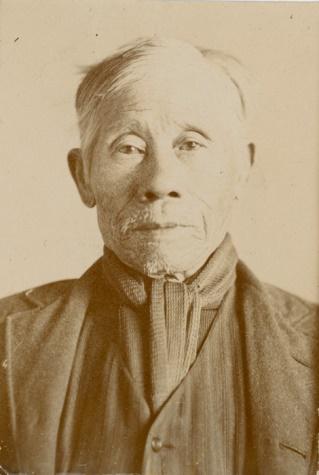The Sam Family

William Flood Sam, 1915. Image courtesy of the National Archives of Australia. NAA: SP42/1, C1915/4058
William Flood Sam emigrated to Australia from Guangdong, China, in 1860. He worked as a miner, cook, labourer, grocer, and market gardener. He married an Australian woman named Jane May White, and they had 16 children. Five of their sons – James, Norman, Henry, George and Tom – served in the Australian Imperial Force (AIF) during the First World War.
James, a 23-year-old miner, enlisted in November 1914 and was assigned to the 4th Battalion. He reached Gallipoli in July 1915, but had the first of several hospital admissions due to illness shortly afterwards. Following the withdrawal of allied forces from Gallipoli, James was sent to Egypt, and eventually sailed to England in September 1916. He saw action on the Western Front in 1918, before returning to Australia in January 1919.
Norman, also a miner, enlisted alongside James in 1914, at the age of 19. He served on Gallipoli with the 4th Battalion, in a different company to his brother. Norman was promoted to corporal in 1917, and was soon sent to fight in France. On 17 April 1918 his head and right hand were damaged by shrapnel. Norman was sent to England for treatment and his index finger was amputated. He returned to Australia in December 1919.
Members of the 4th Battalion queue outside the canteen on Gallipoli, 1915. Cecil Guildford Kimmorley Judge.
Henry, a 32-year-old labourer, enlisted in February 1915 and joined the 17th Battalion. He served on Gallipoli and later on the Western Front. Henry suffered from poor health throughout the war and was hospitalised several times with muscle and joint pain. During a period of recovery in London, he met an English woman named Ethel. They married on 19 February 1917, and returned to Australia in 1919 with their baby.
George, a married motor driver, enlisted in March 1915, aged 25. He was recorded as absent without leave in April, and was discharged from the AIF. George enlisted again in June, denying any previous service on his attestation form. He was assigned to the 4th Battalion, like his two younger brothers. He joined his unit during the final stages of the Gallipoli campaign. After further training in Egypt, George was sent to France in March 1916, where he served for the majority of the war . By August 1918, George had been promoted to sergeant and was overseeing pack animals that carried ammunition forward to machine-gun posts at Chuignes. On 23 August he maintained a constant supply despite heavy fire from the enemy and was awarded the Military Medal for his actions; his coolness, courage, and determination were noted in the citation for the award. He returned to Australia in 1919.
The details of the fifth brother, Tom, are unknown. Though his service was mentioned in newspapers at the time, he does not appear in official records. Two of William and Jane Flood Sam’s grandchildren are also known to have served in the First World War: William and George Loo Long. Despite the White Australia Policy and discriminatory attitudes of the time, the service of the Sam family appears to have been highly regarded by their local community in New South Wales. Upon George Sam’s return to Australia in 1919, the Wyalong Advocate reported “these lads had demonstrated to the world that they were men, seeking to uphold the glorious traditions of the British empire”.

